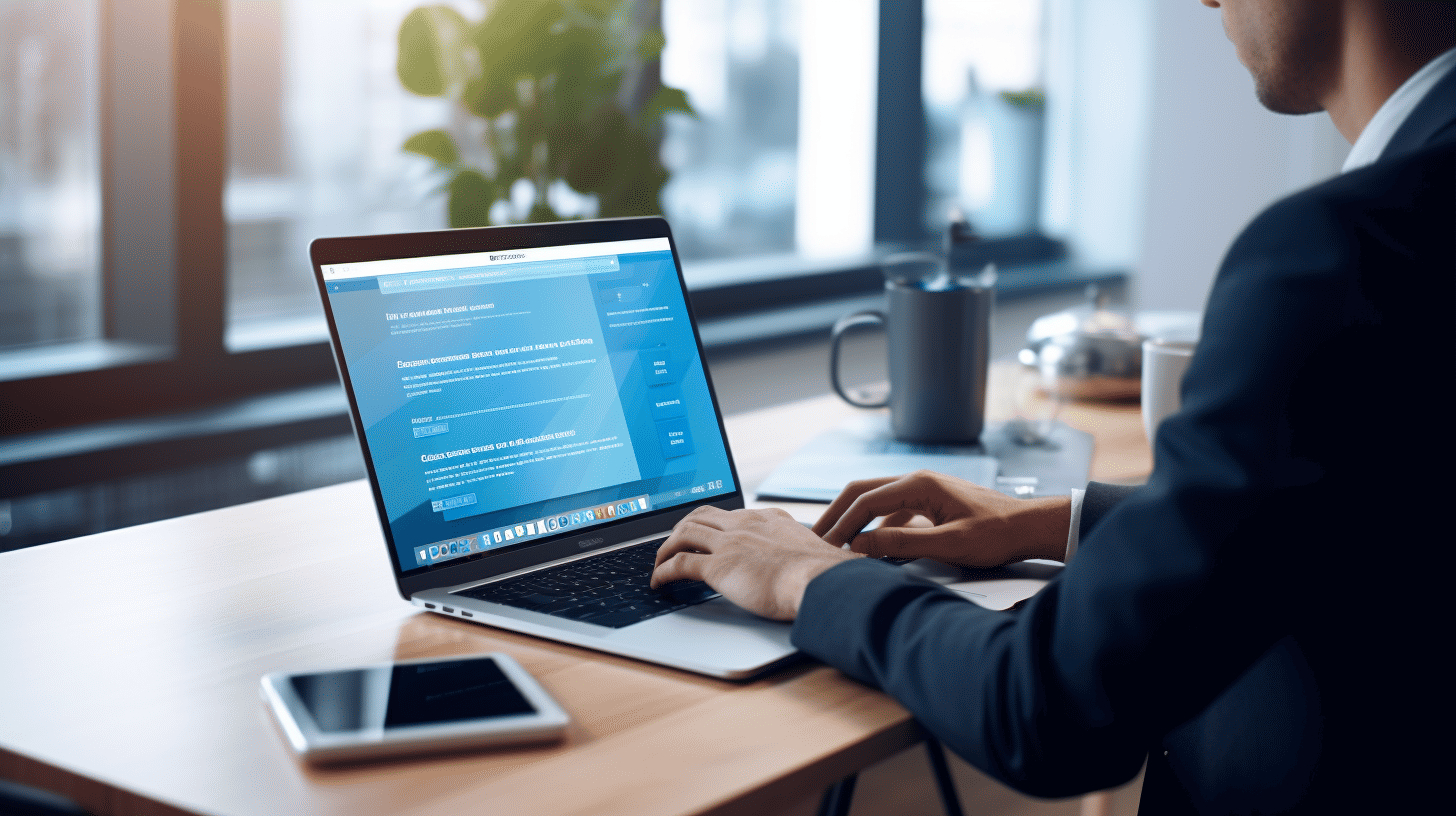在當今數位時代,擁有一個專業的網站對於企業、組織和個人來說都至關重要。當談到創建專業網站時,WordPress 仍然是許多人的首選。 WordPress 擁有使用者友善的介面、豐富的外掛程式庫和可自訂的主題,提供了一個強大的平台來打造令人驚嘆的線上形象。
然而,創建和維護專業的 WordPress 網站不僅僅需要選擇主題和添加內容。它涉及關注最小的細節,確保無縫的用戶體驗,以及實施最佳實踐以最大限度地發揮您網站的潛力。
在本文中,我們將探討建立和維護專業 WordPress 網站的關鍵最佳實務。我們將深入探討可訪問性和用戶友好導航的重要性,討論響應式設計和性能優化的重要性,並重點介紹最新的網站設計趨勢,以保持您的網站具有視覺吸引力和最新性。此外,我們還將討論網站安全和維護,並提供建立低維護 WordPress 網站的見解。
因此,無論您是希望建立線上形象的企業主、展示作品集的自由工作者,還是分享專業知識的部落客,本文都將引導您完成創建專業的 WordPress 網站的過程,讓您脫穎而出。
讓我們開始吧! 🚀
強調可訪問性和用戶友好型導航
2023 年,WordPress 網站設計將更加重視可訪問性和用戶友好的導航。隨著越來越多的企業和個人進入網路領域,確保所有使用者(無論其能力或殘疾情況如何)都能存取網站變得至關重要。此外,用戶友好的導航對於提供無縫和愉快的瀏覽體驗至關重要。
無障礙
可訪問性是指使網站可供殘障人士使用的做法。這包括但不限於視力障礙、聽力障礙、運動障礙和認知障礙的人。透過實施無障礙措施,網站所有者可以確保其內容易於感知、操作和理解。
以下是設計 WordPress 網站時需要考慮的一些可訪問性關鍵方面:
- 替代文字:為圖像提供替代文本,為音頻和視頻內容提供文字記錄,可以讓有視覺或聽覺障礙的用戶理解所呈現的資訊。
- 鍵盤導航:對於無法使用滑鼠或觸控螢幕的使用者來說,確保所有網站功能都可以透過鍵盤存取和控制至關重要。
- 顏色對比:在文字和背景之間使用足夠的顏色對比度,可以讓有視覺障礙的使用者更容易閱讀和理解內容。
- 語意標記:使用適當的 HTML 元素和結構有助於輔助技術準確地解釋並向使用者呈現網站內容。
透過在 WordPress 網站設計過程中優先考慮可訪問性,企業不僅可以增強更廣泛使用者的使用者體驗,還可以遵守法律要求,例如《Web 內容可訪問性指南》(WCAG)。
有關可訪問性在網頁設計中的重要性的更多信息,請訪問 強調可訪問性.
使用者友善的導航
使用者友善的導航是為網站訪客創建無縫、直覺的瀏覽體驗。當用戶可以輕鬆找到他們想要的內容並毫無困惑或沮喪地瀏覽網站時,他們更有可能保持參與並轉化為客戶或常客。
以下是在 WordPress 網站上實現用戶友好導航的一些策略:
- 清晰一致的選單結構:組織良好且合乎邏輯的選單結構可確保使用者可以輕鬆瀏覽網站的不同部分。每個選單項目都應該有一個清晰而有意義的標籤來代表其所指向的內容。
- 麵包屑:麵包屑為使用者提供了一種簡單方法來追蹤他們在網站層次結構中的位置,並允許他們返回到以前訪問過的頁面。
- 搜尋功能:在網站上顯著的位置設定搜尋欄可以讓使用者快速找到特定內容,尤其是當他們清楚知道自己在尋找什麼的時候。
- 響應式設計:隨著智慧型手機和平板電腦的瀏覽使用越來越多,確保您的 WordPress 網站適合行動裝置並在不同裝置之間提供無縫體驗至關重要。
透過注重用戶友善的導航,企業可以降低跳出率、增加參與度,並最終提高轉換率。設計精良且具有直觀導航的 WordPress 網站會給人留下積極的印象並鼓勵訪客進一步探索。
總之,在 2023 年,企業在設計 WordPress 網站時應該優先考慮可訪問性和用戶友好的導航。透過讓所有使用者都能存取網站並提供直覺的導航,企業可以創造包容性的網路體驗並增強用戶參與度。因此,花點時間將這些關鍵元素整合到您的 WordPress 網站設計中,以實現真正以使用者為中心的線上形象。
WordPress 網站設計的關鍵最佳實踐
網頁設計的世界不斷發展,有如此多的選擇和趨勢需要考慮,確保您的 WordPress 網站設計能夠提供最佳的使用者體驗可能會讓人不知所措。為了幫助您應對不斷變化的環境,我們收集了一些 WordPress 網站設計的關鍵最佳實踐。在本文中,我們將探討網站設計的兩個基本面向:響應式設計和效能最佳化。
響應式設計
在當今這個行動驅動的世界裡,擁有一個響應式網站不再是一種選擇,而是一種必需品。隨著越來越多的用戶透過智慧型手機和平板電腦造訪網站,確保您的 WordPress 網站針對不同螢幕尺寸和裝置進行最佳化至關重要。以下是響應式設計時需要考慮的一些最佳做法:
- 行動優先方法:開始設計您的網站時要考慮行動用戶。這種方法可確保您的網站在較小的螢幕上看起來很棒並且無縫運行,然後您可以逐步增強大螢幕的設計。
- 靈活的佈局:使用 CSS 媒體查詢創建流暢、靈活的佈局,可以適應不同的螢幕尺寸。這將允許您的網站相應地調整大小和重新定位其元素,從而提供跨裝置的無縫用戶體驗。
- 優化影像:針對不同的螢幕解析度最佳化您的影像。使用響應式影像技術,例如
原始碼屬性,根據使用者的設備提供適當大小的圖像。 - 測試與優化:在各種裝置和螢幕尺寸上測試您的網站,以確保其外觀和功能符合預期。監控效能指標,例如載入時間和頁面速度,並相應地優化您的設計。
效能最佳化
網站效能對用戶體驗和搜尋引擎排名起著至關重要的作用。加載緩慢的網站會讓用戶感到沮喪並使他們離開您的網站。以下是優化 WordPress 網站效能的一些最佳做法:
- 快取:實作快取機制,例如瀏覽器快取、伺服器端緩存,以儲存靜態檔案並減少伺服器負載。這可以顯著改善回訪者的頁面載入時間。
- 縮小:透過刪除不必要的字元、空格和註解來減少 CSS 和 JavaScript 檔案的大小。最小化可以幫助減少檔案大小,從而加快載入時間。
- 影像優化:在不犧牲品質的情況下壓縮和優化您的影像。使用圖像優化外掛程式或線上工具來減少檔案大小並縮短載入時間。
- 內容傳遞網路 (CDN):利用 CDN 將您的網站內容分發到世界各地的多個伺服器上。 CDN 有助於從最靠近使用者的伺服器提供您的內容,從而減少延遲並縮短載入時間。
請記住,實施響應式設計和優化網站效能是一個持續的過程。根據新興趨勢和技術定期審查和更新您的設計,以保持領先地位。透過遵循這些關鍵的最佳實踐,您可以確保您的 WordPress 網站是一個用戶友好、高效能的平台,讓您的訪客留下正面的印象。
🌐 了解有關 WordPress 網站設計的最佳實踐的更多資訊。
創建專業的WordPress網站
您準備好將您的網站提升到新的水平了嗎?創建專業的 WordPress 網站是建立強大的線上形象並展示您的品牌或業務的絕佳方式。 WordPress 擁有使用者友善的介面和廣泛的自訂選項,是初學者和經驗豐富的 Web 開發人員的首選平台。
在建立專業的 WordPress 網站時,需要考慮幾個基本步驟。在本文中,我們將探討使您的網站與其他網站區分開來的一些關鍵方面。讓我們開始吧!
選擇合適的主題
建立專業的 WordPress 網站的第一步是選擇合適的主題。主題決定了您網站的整體外觀和感覺,因此選擇符合您的品牌標誌和目標的主題非常重要。選擇主題時請記住以下幾點提示:
- 選擇響應式主題:隨著越來越多的人透過行動裝置造訪網站,選擇能夠無縫適應不同螢幕尺寸的響應式主題至關重要。
- 考慮您的行業:尋找專門為您的行業設計的主題。無論您是攝影師、部落客還是小型企業主,都有無數主題可供選擇,滿足您的需求。
- 檢查自訂選項:確保您選擇的主題提供足夠的自訂選項,以使您的網站獨一無二。可自訂的標題、配色方案和字體樣式對於創建專業且有凝聚力的外觀大有幫助。
自訂視覺元素
選擇主題後,就可以自訂網站的視覺元素了。關注視覺細節可以顯著改變訪客對您的網站的看法。以下是需要考慮的幾個因素:
- 標誌和品牌:在整個網站中融入您的標誌和品牌顏色,以建立一致且可識別的品牌標識。
- 高品質圖像:使用與您的內容相關的高品質圖像來吸引訪客的注意。請記住,一張圖片勝過千言萬語!
- 字體:選擇易於閱讀且符合您品牌個性的字體。保持字體大小和樣式的一致性以獲得美觀的外觀。
製作引人入勝的內容
創建引人注目的內容是吸引受眾並鼓勵他們進一步探索您的網站的關鍵。以下提示可協助您製作出引人注目的內容:
- 定義您的目標受眾:確定您的目標受眾是誰,並自訂您的內容以吸引他們的興趣和需求。
- 使用引人入勝的標題:使用引人注目且資訊豐富的標題吸引觀眾的注意。不要害怕發揮創意!
- 創建有價值且資訊豐富的內容:提供與您的受眾相關的見解、技巧和解決方案。這將建立信任並使您的網站成為可靠的資訊來源。
簡潔實用的 UI 設計
除了選擇主題和自訂視覺元素之外,簡潔、實用的 UI 設計也至關重要。精心設計的使用者介面可以大大增強使用者體驗,並使您的網站更容易被搜尋引擎發現。這就是為什麼 UI 設計如此重要:
- 簡潔的佈局:使用簡潔、有序的佈局,讓訪客可以輕鬆瀏覽您的網站。避免混亂並優先考慮最重要的內容。
- 充足的空白:空白對於提供視覺喘息空間和提高可讀性起著至關重要的作用。它有助於突出顯示關鍵元素並使您的網站具有視覺吸引力。
透過遵循這些步驟並專注於這些重要方面,您將能夠創建一個在競爭中脫穎而出的專業 WordPress 網站。
現在您已經有了創建專業 WordPress 網站的清晰路線圖,是時候擼起袖子開始建造了!看此文章 建立 WordPress 網站 以獲得進一步的啟發和指導。祝你好運! 😊
2023 年網站設計趨勢
隨著技術的不斷發展,網站設計趨勢也在不斷變化並適應最新的創新。展望 2023 年,企業和網站所有者必須保持領先地位並保持網站的新鮮和吸引力。在本文中,我們將探討一些預計在 2023 年佔據主導地位的令人興奮的網站設計趨勢。
色彩鮮豔🔆
2023 年最大的網站設計趨勢之一是使用明亮的色彩。設計師越來越多地採用充滿活力和引人注目的配色方案來吸引用戶的注意力並創造難忘的瀏覽體驗。柔和單調的配色方案的時代已經一去不復返了——2023 年的重點是擁抱大膽的色調並彰顯個性。
以下是在網站設計中實現明亮色彩的幾種方法:
- 充滿活力的背景: 使用大膽而鮮豔的顏色作為背景可以立即提升網站的整體外觀和感覺。
- 彩色字體: 嘗試使用獨特且對比鮮明的顏色作為標題和文字可以吸引人們對關鍵訊息的注意並使其更容易記住。
- 顏色疊加: 在圖像上應用半透明彩色覆蓋可以增加網站設計的深度和視覺趣味。
請記住,明亮色彩的使用應始終保持平衡並與您的品牌標誌保持一致。策略性地結合起來以突出重要元素並喚起觀眾所需的情感。
實現人工智慧🤖
人工智慧(AI)已經改變了各行各業,網站設計也不例外。預計到 2023 年,將 AI 融入網站設計將變得更加普遍。人工智慧功能可以增強使用者體驗並簡化流程,使網站更具互動性和效率。
以下是在網站設計中實現AI的幾種方法:
- 個性化內容: 使用人工智慧演算法,網站可以分析用戶行為並根據每個訪客的喜好和興趣提供個人化內容。
- 聊天機器人: 人工智慧聊天機器人提供即時客戶支援、回答常見問題並協助用戶瀏覽網站。
- 語音接口: 由人工智慧驅動的語音控制介面可以使網站更易於存取和用戶友好,允許用戶使用語音命令與網站進行互動。
透過採用人工智慧技術,網站可以提供更好的使用者體驗,提高客戶參與度並保持競爭優勢。
使用聊天機器人💬
2023 年網站設計領域的另一個新興趨勢是使用聊天機器人。聊天機器人是模擬人類對話並對使用者查詢提供即時回應的電腦程式。對於尋求提供快速、高效客戶支援的企業來說,它們變得越來越受歡迎。
以下是在您的網站上使用聊天機器人的一些好處:
- 24/7 全天候服務: 聊天機器人可以全天候處理客戶詢問,確保訪客總是能及時得到幫助。
- 縮短反應時間: 透過自動回應常見查詢,聊天機器人可以提供即時答案並節省使用者和企業的時間。
- 經濟高效的客戶支援: 實施聊天機器人可以減少對大型客戶支援團隊的需求,進而為企業節省成本。
聊天機器人還可以進行自訂以配合您的品牌聲音,從而使對話更加個性化和吸引用戶。
總之,隨著我們步入 2023 年,了解最新的網站設計趨勢非常重要。融入明亮的色彩、實現人工智慧和使用聊天機器人只是可以幫助企業創建引人入勝且用戶友好的網站的新興趨勢中的一小部分。透過適應這些趨勢,企業可以增強用戶體驗、提高參與度並最終實現其網站目標。
要了解有關 2023 年最新網站設計趨勢的更多信息,請查看此 資源.
網站安全和維護
介紹:
在當今的數位環境中,確保您網站的安全和維護比以往任何時候都更加重要。安全的網站可以讓訪客信任您,並保護敏感資料免受潛在威脅。此外,定期維護有助於優化您網站的效能並確保其順利運作。在本節中,我們將探討網站安全和維護的兩個關鍵面向:定期更新和備份以及安全措施。
定期更新:
定期更新您的 WordPress 核心、主題和外掛程式對於網站安全至關重要。透過讓您的網站軟體保持最新,您可以受益於最新的安全性修補程式、錯誤修復和功能增強。以下是定期更新至關重要的幾個主要原因:
- 安全:更新通常包括安全性修復程序,用於解決駭客可能利用的漏洞。透過保持最新狀態,您可以最大限度地降低安全漏洞的風險並保護您的網站及其訪客。
- 相容性:更新可確保您的網站與最新版本的外掛程式、主題和其他元件保持相容。這降低了出現可能破壞您網站功能的相容性問題的可能性。
- 新功能:更新通常會帶來新功能和改進,增強用戶體驗並允許您利用最新的工具和技術。
請記住在執行更新之前務必進行備份。這樣,如果更新過程中出現任何問題,您都有一個安全網。
備份和安全措施:
定期備份和有效的安全措施對於維護安全的 WordPress 網站非常重要。這就是為什麼它們至關重要:
- 資料保護:如果發生資料遺失、意外刪除或安全漏洞,備份可以作為安全網。透過定期備份,您可以根據需要輕鬆地將網站還原到以前的工作狀態。
- 減少停機時間:如果發生安全漏洞或網站入侵,擁有安全備份可以讓您快速恢復網站並最大限度地減少停機時間。對於依賴網站作為主要收入來源或客戶互動的企業來說,這一點尤其重要。
- 安全插件:利用安全插件可以透過主動監控和防禦潛在威脅來提供額外的保護層。這些外掛程式可以幫助偵測和阻止可疑活動、保護登入憑證並提供即時安全警報。
透過定期執行維護任務,包括備份、更新和優化網站效能,您可以確保 WordPress 網站的持續安全性和功能。
「成功的網站管理包括定期更新、備份和安全措施,以保護您的網站、訪客和資料。”
有關保護 WordPress 網站安全的更多詳細信息,請查看此內容 網站安全和維護 文章。
建立低維護的 WordPress 網站
在當今快節奏的數位世界中,擁有一個低維護的網站對於企業和個人來說都至關重要。低維護的 WordPress 網站不僅可以節省您的時間和精力,還可以確保您的線上業務順利且有效率地運作。那麼如何才能建立一個只需要最少維護的網站呢?讓我們探索一些可以幫助您實現這一目標的關鍵策略。
選擇一個簡單的主題
建立低維護的 WordPress 網站的第一步是選擇一個簡單的主題。雖然有成千上萬種美觀且功能豐富的主題可供選擇,但選擇更簡單的設計可以顯著減少持續更新和維護的需要。原因如下:
- 輕量級:簡單主題通常很輕量級,這意味著它們具有較少的程式碼行和較少的功能。這不僅可以提高您網站的載入速度,還可以降低未來 WordPress 更新出現相容性問題的可能性。
- 輕鬆自訂:簡單主題通常提供直接的客製化選項,讓您無需深入研究複雜的編碼即可更改網站的外觀。這使您能夠創建具有視覺吸引力的網站,而無需不斷調整。
請記住,視覺上令人驚嘆的網站不一定很複雜。透過選擇一個簡單的主題,您可以為一個低維護且仍能吸引訪客注意力的網站奠定基礎。
謹慎使用插件
外掛程式可以增強您的 WordPress 網站的功能,但使用過多的外掛程式可能會導致日後維護麻煩。為了使您的網站精簡且易於管理,謹慎使用外掛程式至關重要。原因如下:
- 相容性問題:您安裝的每個外掛程式都會為您的網站添加額外的程式碼,從而增加衝突和相容性問題的可能性。隨著 WordPress 的發展和核心軟體的更新,外掛程式也必須跟上,通常需要定期更新。透過限制插件的數量,您可以降低因程式碼衝突或相容性過時而產生問題的風險。
- 安全漏洞:有些外掛程式可能存在可被駭客利用的漏洞。安裝的插件越多,惡意攻擊的潛在入口點就越多。透過保持插件數量較少,您可以最大限度地降低與您的網站相關的安全風險。
在安裝新插件之前,請問自己是否真的有必要。在主題功能中尋找替代解決方案或探索可用於多種用途的輕量級、多用途外掛程式。
取得託管主機
選擇正確的託管服務提供者是建立低維護 WordPress 網站的關鍵方面。選擇託管主機可以對您網站的順利運作和維護產生很大的影響。方法如下:
- 自動更新和備份:託管服務提供者處理技術方面的問題,包括自動更新您的 WordPress 核心、主題和外掛程式。他們還會定期備份,確保您的網站始終保持最新狀態,並且在出現任何不可預見的問題時可以輕鬆恢復。
- 效能優化:託管服務提供者通常會為 WordPress 網站提供特定的最佳化。這些優化可以包括伺服器級快取、內容分發網路 (CDN) 和其他效能增強,以確保您的網站快速且有效率地載入。
- 專家支援:透過託管主機,您可以接觸到專門從事 WordPress 的專家團隊。無論您遇到技術問題還是對優化網站有疑問,他們的支援都可以為您節省時間和壓力。
透過選擇託管,您將網站的技術方面委託給專業人士,讓您專注於創建內容和擴大您的線上影響力。
透過選擇一個簡單的主題,謹慎地使用插件,並選擇託管主機,就可以建立一個低維護的 WordPress 網站。透過實施這些策略,您可以節省時間、精力和潛在的麻煩,確保您的網站長期保持高效和有效。
結論
創建和維護專業的 WordPress 網站需要仔細關注設計、可用性和安全性。透過遵循本文討論的最佳實踐,您可以確保您的網站脫穎而出、吸引用戶並提供卓越的體驗。
請記住,在當今的數位環境中,優先考慮可訪問性和用戶友好導航至關重要。利用響應式設計技術確保您的網站在所有裝置上都能完美顯示和運作。透過最小化載入時間並優化圖像和程式碼來優化效能。
在設計方面,選擇與您的品牌相符的合適主題並自訂視覺元素以建立具有凝聚力和視覺吸引力的網站。製作引人入勝的內容來吸引您的觀眾,並利用簡潔實用的 UI 設計原則來增強可用性。
了解 2023 年的最新網站設計趨勢,包括使用明亮的色彩、實施人工智慧以及利用聊天機器人來增強用戶參與度。
不要忘記網站的安全和維護。定期更新您的 WordPress 核心、主題和插件,並實施備份和安全措施以保護您的網站免受潛在威脅。
對於低維護的網站,請選擇一個簡單的主題,謹慎使用插件,並考慮投資託管主機。 Managed-WP™ 是一種高級託管 WordPress 雲端託管平台,它簡化了您網站的基礎架構、提供了自由的數位體驗,並提供專家的 24/7/365 問題解決支援。
透過這些最佳實踐和正確的工具和資源,您可以建立和維護一個專業的 WordPress 網站,給訪客留下深刻印象、推動轉換並幫助您實現線上目標。
立即開始使用 Managed-WP™ 建立您的專業 WordPress 網站。 查看 Managed-WP™ 了解有關他們如何簡化您的託管體驗的更多資訊。
常見問題解答
- 創建專業 WordPress 網站的最佳實踐是什麼?
創建專業 WordPress 網站的一些最佳實踐包括選擇簡潔現代的主題、使用高品質的圖像、組織具有清晰導航的內容、優化網站速度以及實施響應式設計。
- 如何維護專業的 WordPress 網站?
要維護專業的 WordPress 網站,請定期更新 WordPress 核心、主題和插件,定期備份您的網站,監控網站性能,修復斷開的鏈接,優化 SEO,並定期發布新鮮有價值的內容。
- 行動響應能力對於專業的 WordPress 網站來說有多重要?
行動響應能力對於專業的 WordPress 網站至關重要,因為它可以確保您的網站在不同裝置上正常顯示和運行。隨著行動裝置的使用越來越多,擁有一個行動友善的網站可以提供更好的用戶體驗並提高 SEO 排名。
- 我應該對我的專業 WordPress 網站採取什麼安全措施?
是的,為您的專業 WordPress 網站採取安全措施非常重要。這包括安裝安全性外掛程式、使用強密碼、啟用雙重認證、定期更新 WordPress、主題和外掛程式以及定期備份您的網站。
- 有哪些推薦的外掛程式可用於維護專業的 WordPress 網站?
一些用於維護專業 WordPress 網站的推薦外掛是:iThemes Security、備份的 UpdraftPlus、用於快取和網站速度的 WP Rocket、用於 SEO 優化的 Yoast SEO 和用於網站分析的 MonsterInsights。



















